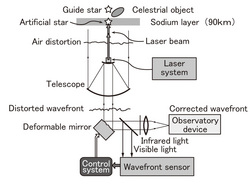Nagoya City Science Museum
TOP > Exhibition Guide > Keyword Search > Starting with "O" > observation > Scintillation
Scintillation

Purpose of Exhibition
This exhibit had been removed.
This exhibit will end in October 2023. This page will also be gone at the end of this financial year.
Light from stars must pass through the atmosphere, which is made up of layers of air, to reach your eyes. Each layer has a slightly different density, due to differences in temperature, or wind blowing through them. These fluctuations refract the light almost imperceptibly, and your eyes perceive the accumulation of these small deflections as the flickering of a star, or the overlapping of two nearby stars into one. This phenomenon is called “Scintillation,” in which stars appear to be flickering or twinkling on account of uneven air. You see stars much more twinkling when they are lower in the sky, near the horizon; this is because they have a longer travel through the atmosphere.
This exhibit will show you how stars appear to be flickering, and an experimental device will demonstrate that atmospheric disturbance is responsible for the twinkling of stars.


Additional Knowledge
How to Reduce the Effect of Scintillation
[Location with Low Scintillation]
To study the structure of the Universe in greater detail with large telescopes, we need observatories in a site not only with dark skies, but also less affected by scintillation. If atmospheric turbulence distorts the image of a star even by, say, one second of arc, we will not be able to observe structures finer than that one second. As a result, scintillation noise can spoil the performance of telescopes even with higher angular resolution.
This is why most large telescopes are located on high mountains with thin atmosphere, such as Mauna Kea in Hawaii. Furthermore, many space telescopes have been launched into space above the effect of the atmosphere, including Hubble Space Telescope placed into the earth’s orbit in 1990.
[Adaptive Optics]
Meanwhile, we have been developing a system to minimize the effect of scintillation on ground-based observations. This technology, called “Adaptive Optics,” is applied in many large telescopes, such as Subaru Telescope. The atmospheric blurring of a target is instantly removed by a deformable mirror which continuously changes the reflective surface shape with reference to a bright, nearby star to help correct images, namely the guide star.
In addition, Subaru can actually generate artificial guide stars. Even when no suitable bright star is available, a laser beam would shoot 90km into the sodium layer, exciting atoms to emit light. Subaru Telescope is designed to use adaptive optics technology for any objects in any direction.
This page was last edited on 15 June 2022.
Article by Astronomy Section
